Table of Contents
- Understanding the Role of Voltage in Stun Gun Effectiveness
- Decoding Amperage and Its Impact on Safety and Performance
- Balancing Voltage and Amperage for Optimal Self-Defense Tools
- Expert Tips for Choosing the Right Stun Gun Based on Electrical Specs
- Insights and Conclusions
Understanding the Role of Voltage in Stun Gun Effectiveness
The voltage rating of a stun gun is often the first spec that catches the eye, but its significance goes beyond just a high number. Voltage is essentially the electrical pressure that pushes current through the target’s body. Higher voltage allows the stun gun to overcome clothing, moisture, and resistance in the skin, ensuring the electric shock effectively disrupts the muscle and nerve functions. This high voltage is what enables the stun gun to temporarily incapacitate an attacker by scrambling their neuromuscular signals, causing loss of motor control and disorientation.
However, voltage alone doesn’t determine effectiveness. The duration of the pulse, the frequency of shocks, and most importantly, the amperage (current) play critical roles in how impactful the stun gun will be. Current is responsible for the actual muscle disruption and pain delivered, and even small amounts can have significant effects when administered at high voltage. Key factors affecting effectiveness include:
- Penetration capability: High voltage helps penetrate clothing layers.
- Shock duration: Longer pulses create sustained disruption in muscle activity.
- Electric current amount: Controls the intensity of muscle contractions and pain level.
- Pulse frequency: Repeated shocks prevent the attacker from regaining control quickly.
Understanding the balance between voltage and amperage is crucial for selecting a stun gun that is both safe and effective. Simply opting for the highest voltage model may not guarantee the best results, as the interplay of electrical parameters determines the true stopping power.
Decoding Amperage and Its Impact on Safety and Performance
When it comes to stun guns, amperage plays a pivotal role in determining both safety and effectiveness. Unlike voltage, which pushes the electrical energy through a target, amperage controls the actual current delivered. This current is what interferes with the body’s neuromuscular system, causing temporary incapacitation. Too low an amperage may render the device ineffective, while too high can increase the risk of serious injury. Manufacturers carefully calibrate amperage levels to strike a balance between stopping an assailant and minimizing permanent harm.
Understanding amperage also reveals why safety mechanisms are crucial. Many stun guns include built-in features to regulate current flow, such as:
- Automatic shut-off timers that limit exposure duration
- Current limiting components to prevent excessive discharge
- Variable output settings for controlled use in different situations
Balancing Voltage and Amperage for Optimal Self-Defense Tools
When selecting a stun gun, it’s crucial to understand how voltage and amperage work together to deliver an effective self-defense tool. Voltage is the electrical force that propels the current through the target’s body, while amperage is the actual flow of electrons that disrupt muscle control. High voltage alone doesn’t guarantee effectiveness if the amperage is insufficient to interfere with the neuromuscular system. In essence, voltage acts like the “pressure,” and amperage functions as the “volume” of the electric shock. Finding the right balance ensures the stun gun can incapacitate an attacker quickly without causing lasting harm.
The optimal stun gun should feature:
- High voltage to overcome natural resistance like clothing or body fat.
- Sufficient amperage to create intense pain and neuromuscular disruption, immobilizing the target.
- Safe current limits that minimize risk of permanent injury.
By appreciating these electrical dynamics, users can make informed choices about their devices, ensuring maximum effectiveness and personal safety in critical moments.
Expert Tips for Choosing the Right Stun Gun Based on Electrical Specs
When selecting a stun gun, understanding the interplay between voltage and amperage is crucial. Voltage represents the electric potential that initiates the shock, while amperage controls the strength and duration of the current delivered. Higher voltage stun guns are capable of penetrating thicker clothing and providing an immediate incapacitating effect. However, a stun gun with excessive voltage but low amperage may only cause discomfort without truly disabling an attacker. Aim for a balance that offers both a strong initial shock and sufficient current flow to ensure effectiveness.
Consider these electrical specifications for an optimal choice:
- Voltage Range: 50,000 to 1,000,000 volts – higher voltages increase penetration but watch out for legal restrictions.
- Amperage: Typically between 1 to 4 milliamperes – enough to cause temporary muscle control loss but safe for most users.
- Duration of Shock: Longer shock durations provide sustained deterrence, but consider battery life.
- Safety Features: Look for built-in automatic shut-offs and finger guards to prevent accidental injury.
Insights and Conclusions
In conclusion, grasping the science behind stun gun voltage and amperage is crucial for understanding how these devices deliver effective self-defense while minimizing lasting harm. Voltage determines the ability to overcome a target’s resistance, while amperage controls the actual current flow responsible for disrupting muscle control. By appreciating the balance between these two factors, users can make informed decisions about the stun guns that best suit their safety needs. Whether you’re considering a stun gun for personal protection or simply eager to understand the technology, recognizing the interplay of voltage and amperage provides valuable insight into how these devices function in real-world scenarios. Stay informed, stay safe, and always prioritize responsible use.Check Our Other Blogs
- StunGun – Your Trusted Source for Stun Guns, Laws, and Self-Defense Tips
- PepperSprayLaws – Your Trusted Resource for Pepper Spray Information
- StunGunLaws – Your Trusted Guide to Stun Gun Legality and Safety





